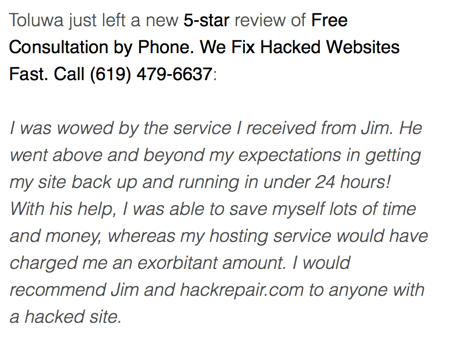
Listen to article, “The Blacklist Blues: How a Bad Reputation Can Ruin Your Business and How to Deal With Being Blacklisted”
Keeping your online reputation in good standing is critical as a business owner in today’s world. One of the biggest threats to your online reputation is being blacklisted.
In this article, we will take a closer look at blacklists, provide a detailed guide on what they are, the different types of blacklists, how to avoid getting blacklisted, and what to do if you end up on one.
What are Blacklists?
Blacklists are email addresses, IP addresses, or lists of domains or URLs that have been identified as malicious, spammy, or fraudulent. Essentially, they’re lists of entities that are not to be trusted. These lists are often used by email providers, search engines, and other online services to filter out unwanted content and protect their users from harmful and spammy websites.
There are three different types of blacklists that you should be aware of:
- Email blacklists.
- IP blacklists.
- and Domain blacklists.
I’ll Try My Best Now to Explain Each of the Three Types of Blacklists Below.
Email Blacklists
Email blacklists are lists of email addresses that have been flagged as spam or otherwise suspicious. These lists are maintained by various organizations, including email providers, spam filters, and third-party companies that specialize in email reputation.
The following are ten of the most popular blacklists or blacklist-related services:
- MXToolBox – Online network diagnostic tool that provides DNS lookup, blacklist check, email header analyzer, and more.
- DNSBL.info – Blacklist lookup tool for IP addresses, email addresses, and domains.
- Multirbl.valli.org – Aggregated blacklist lookup tool that checks against multiple blacklist databases.
- Microsoft Office 365 Delisting Tool – Microsoft’s Office 365 Anti-Spam IP Delist Portal.
- Spamhaus Zen – This more comprehensive Spamhaus managed blocklist is used by most hosting companies.
- SORBS – Spam and Open Relay Blocking System that provides spam filtering and blocking services for email servers.
- SURBL – Spam URI Real-time Blocklists that checks for malicious websites in emails and websites.
- SpamCop – Email reporting and spam tracking service that reports spam and other abusive emails to network providers.
- SpamRATS – Real-time Blacklist that provides IP-based spam filtering services for email servers.
- Spamhaus – Non-profit organization that provides spam filtering and blocking services for email servers.
IP Address Blacklists
IP blacklists are lists of IP addresses that have been identified as malicious or spammy. These lists are often used by email providers, search engines, and other online services to block traffic from suspicious or dangerous IPs.
The following are ten of the most well-known IP address blacklists or IP address related blacklist services:
- SpamCop – Email spam reporting service.
- Barracuda Reputation Block List (BRBL) – Email blocklist service that identifies IP addresses used by spammers.
- Spamhaus Zen – Email blocklist service that provides real-time anti-spam protection for email systems.
- CBL (Composite Blocking List) – Email blocklist service that identifies and blocks spam sources.
- SORBS – Email blocklist service that identifies and blocks spam and open relays.
- Spamhaus PBL (Policy Block List) – Email blocklist service that identifies IP addresses that should not be sending email directly to mail servers.
- Barracuda Reputation Block List (BRBL) – Email blocklist service that identifies IP addresses used by spammers.
- Return Path Reputation Network – A network that provides email reputation and blocklist lookup services.
- Spamhaus XBL (eXploits Block List) – Email blocklist service that identifies and blocks computers that have been compromised and are being used to send spam.
Domain Blacklists
Domain blacklists are lists of domains that have been flagged as malicious, spammy, or otherwise suspicious. These lists are often used by email providers, search engines, and other online services to block traffic from harmful or spammy domains.
The following are many of the most popular domain blacklists or domain blacklist-related services:
- SURBL – A list of websites that have been identified as sources of spam or malicious content.
- URIBL – A DNS-based blacklist that identifies spammy URLs in email messages.
- Spamhaus DBL – A domain-based blacklist that helps block email messages containing spam, malware, and other malicious content.
- Barracuda Reputation Block List – A private, reputation-based blacklist that helps block unwanted email traffic.
- SpamCop – A reporting service that allows users to report spam email messages and identify the source of the spam.
- MultiRBL – A multi-DNSBL checker that helps identify spam sources, open relays, and other threats.
- SORBS DUHL – A DNS-based blacklist that identifies open relays, spammers, and other email-based threats.
- AOL’s Domain Blacklist – Like Barracuda, is a private, reputation-based blacklist that helps block unwanted email traffic.
How to Avoid Getting Blacklisted
Prevention is always the best approach when it comes to avoiding blacklists. Here are five tips to help you avoid being blacklisted:
- Keep Your Website Secure.
Make sure your website is secure and free from vulnerabilities that could be exploited by hackers. This includes using strong passwords, keeping your software up to date, and regularly scanning your website for malware. - Follow Best Email Practices.
When it comes to email, follow best practices to avoid getting flagged as spam. This includes:
- Using a reputable email marketing software.
- Using a reputable email service provider.
- Avoiding certain trigger words.
- Keep your email lists clean and up to date. Only send emails to people who have opted into your list.
- And avoid sending mass emails to unengaged recipients.
- Monitor Your Online Reputation. Regularly monitor your online reputation to catch any negative comments or reviews early. Respond promptly and professionally to any negative feedback and take steps to address the issue.
- Implement email authentication. Implementing email authentication, such as SPF, DKIM, and DMARC, can help verify the authenticity of your emails and reduce the likelihood of being blacklisted.
- Monitor your IP address. Monitoring your IP address can help identify any issues that may cause it to be flagged as a source of malicious content.
Consequences of Being Blacklisted
Being blacklisted can have serious consequences for your business. Here are some of the most common consequences:
- Decrease in Traffic. Being blacklisted can lead to a decrease in traffic to your website, as search engines and other online services may block traffic from your IP or domain.
- Loss of Revenue. A decrease in traffic can lead to a loss of revenue, as fewer visitors to your website means fewer potential customers.
- Damage to your online Reputation. Being blacklisted can damage your online reputation, as potential customers may view your website as untrustworthy or spammy.
What to Do if You’re Blacklisted
If you find yourself on a blacklist, don’t panic. Here are some steps you can take to remove yourself from a blacklist:
-
Identify the Blacklist
First, identify the blacklist that you’re on. You can do this by checking your email logs, reviewing your website traffic logs, or use an online blacklist checker. Below are my four favorite free blacklist checking service websites:
- HextrixTools – is an IP address and domains blacklist checking service.
- MX Toolbox – is an email blacklist checking service.
- URLVoid – is another IP address and domains blacklist checking service.
- Virustotal – provides URL and file malware detection checks.
- DNSChecker – is an IP address blacklist & email blacklist check service.
-
Determine the Reason for Being Blacklisted
- Once you’ve confirmed that your website, IP address, or email address has been blacklisted, the next step is to determine the reason behind it. This step is crucial in fixing the issue and preventing future blacklisting. There are various reasons why a website or IP address could be blacklisted, including spamming, phishing, malware, or hacking attempts.
- One of the most common reasons for being blacklisted is spamming. If you have been sending bulk emails to subscribers who did not opt-in or did not give you permission to send them emails, your IP address may be flagged as a spammer. Email service providers have advanced tools to detect spam emails and they automatically blacklist IP addresses that send spam.
- Another reason why websites and IP addresses get blacklisted is phishing. Phishing is a fraudulent practice of attempting to obtain sensitive information like usernames, passwords, and credit card details by disguising oneself as a trustworthy entity in electronic communication. Cybercriminals often use phishing to steal sensitive information from unsuspecting internet users.
- Malware infections and hacking attempts are also common reasons for being blacklisted. Malware is any software that is designed to harm or exploit any computer system. If your website is infected with malware, it can spread to other websites sharing your hosting account or even to other computers, which could lead to blacklisting. If you have a question about website hacking attempts, please feel free to call me anytime and I’ll review with you by phone.
-
Tips to Avoid Being Blacklisted
To avoid being blacklisted, you need to follow some best practices that will help you maintain a positive online presence. Here are some tips:
- Follow email marketing best practices: When sending emails, always ensure that your subscribers have opted-in to receive your emails. Don’t send bulk emails to people who didn’t give you permission to do so. Also, make sure that your email content is relevant, engaging, and informative.
- Keep your website updated and secure: Regularly update your website with fresh and relevant content. Make sure that your website is secure and protected from malware and hacking attempts. Install a reliable security plugin or software and keep it updated.
- Monitor your online reputation: Keep an eye on what people are saying about your business online. Use tools like Google Alerts and social media monitoring tools to track mentions of your brand.
- Don’t engage in spammy activities: Avoid using shady techniques like link buying or keyword stuffing. These activities are not only frowned upon by search engines but can also get you blacklisted.
-
Removing Your Email Address, IP Address, or Website, from a Blacklist
If you discover that you have been added to a blacklist, don’t worry! There are actions you can take to have your website, IP address, or email address removed from the list.
The first step is to determine the reason for being blacklisted, as we discussed earlier.
Once you know the reason, you can take the necessary action to fix the problem.For example, if your email address was blacklisted for sending spam, you need to stop sending spam immediately. You should also check if your email account has been hacked and someone else is sending spam from it. In that case, you need to change your password and enable two-factor authentication to prevent future attacks. Once you have taken these steps, you can request a removal from the blacklist.
If your IP address was blacklisted, you need to identify the source of the problem. It could be that your server has been compromised, or that your website is sharing an IP address with a spammer. You can contact your hosting provider to get help in identifying the issue and resolving it. Once the issue is resolved, you can request a removal from the blacklist.
If your website was blacklisted because it was infected with malware, you need to clean it up first. Please feel free to call me if you would like help in securing your website account or WordPress installation. Once your website is clean, you can request a review from the blacklist provider to have it removed from the list.
Online Reputation Management Services
Maintaining a positive online reputation can be challenging, especially if you have a large online presence. Fortunately, there are many online reputation management services available to help you monitor and maintain your online reputation. These services and their tools will help you monitor your online presence, track mentions of your brand, and manage your online reviews. They also provide insights into your online reputation and suggest ways to improve it. Below are a number of the most popular services and description of each:
- Google Alerts – Google Alerts is a free tool that sends notifications when your brand is mentioned online. It is helpful for monitoring your reputation and responding to negative feedback or reviews.
- Gadook – Gadook offers personalized reputation management solutions to help businesses and individuals maintain a positive online presence.
- Go Fish Digital – Go Fish Digital is a digital marketing agency that specializes in online reputation management, including content removal, suppression, and review management.
- Netmark.com – Netmark.com is a digital marketing agency that provides reputation management services along with other digital marketing services like search engine optimization and content marketing.
- Reputation Defense Network – Reputation Defense Network provides online reputation management services, including content removal and suppression, as well as reputation monitoring and protection.
- InternetReputation.com – InternetReputation.com is a company that provides personal reputation management services to individuals, including removing negative content from search results and improving online presence.
- NetReputation – NetReputation offers ultra-responsive customer support for businesses and individuals seeking to improve their online image and remove negative content from search results.
- Podium – Podium is a platform that helps businesses manage customer interactions and online reviews, as well as improve their online reputation through increased customer engagement and feedback.
- Reputation.com – Reputation.com is an online reputation management platform that helps businesses monitor, manage, and improve their online reputation through review management, social media monitoring, and other reputation management solutions.
If you have comments or suggestions on any of the above service, please post a comment below.
In Conclusion
In today’s online business world, a negative online reputation can be a major threat to your business success. Blacklists are one of the biggest culprits, but by following the recommendations outlined in this article, you can avoid getting blacklisted and take action to remove yourself from a blacklist if necessary.
To maintain a positive online reputation, it’s important to be proactive in managing it. This means monitoring your reputation regularly and responding promptly to any negative feedback or reviews. Doing so can help reduce the impact of being blacklisted and even capture additional business with the right tone.
If you have jumped to the end of this article looking for the bottom-line, let me emphasize that prevention is key when it comes to dealing with blacklists. Likewise, by being transparent about your business practices, creating high-quality content, and using online reputation management tools, you can help protect your online reputation and ensure your business’s long-term success. Don’t let blacklists hold your business back – take action today to safeguard your online reputation.
Frequently Asked Questions Relating to Blacklists and Reputation Management Services:
Q: What is a blacklist?
A: A blacklist is a list of email addresses, IP addresses, or domains that are associated with spam or other malicious activities.
Q: How can a business avoid being blacklisted?
A: Businesses can avoid being blacklisted by using best practices such as using a valid “From” email address, avoiding misleading subject lines or content, including an unsubscribe link, and using a double opt-in process.
Q: What are the consequences of being blacklisted?
A: Being blacklisted can have several negative consequences, including reduced email deliverability, decreased website traffic, and reduced sales or revenue.
Q: What are some popular online reputation management tools?
A: Some popular online reputation management tools include Google Alerts, Hootsuite, and Brandwatch.
Q: How can a business remove themselves from a blacklist?
A: If a business is blacklisted, they can take steps to remove themselves from the blacklist, such as identifying the blacklist, contacting the blacklist provider, and taking corrective action to resolve the issue that caused blacklisting.
Q: Why is it essential for a business to maintain a positive online reputation?
A: Maintaining a positive online reputation is essential for businesses as it can impact their website traffic, revenue, and overall success.
Q: What is online review management?
A: Online review management is the process of monitoring and responding to customer reviews online to maintain a positive reputation.
Q: How can a business monitor their online reputation?
A: Businesses can monitor their online reputation by using online reputation management tools such as social media monitoring, online review management, and search engine reputation management.
Q: Can using online reputation management tools prevent a business from being blacklisted?
A: While online reputation management tools cannot directly prevent a business from being blacklisted, they can help businesses maintain a positive online presence and take corrective action if they are blacklisted.
Q: What are some well-known blacklists?
A: Spamhaus (RBL list: sbl.spamhaus.org), Barracuda (RBL list: b.barracudacentral.org), Sorbs, SpamCop (RBL list: bl.spamcop.net), XBL Exploits (RBL list: xbl.spamhaus.org), CBL (RBL list: cbl.abuseat.org), and Return Path Reputation Network (RBL list: bl.score.senderscore.com).
Q: Can a business be blacklisted without knowing it?
A: Yes, a business can be blacklisted without knowing it, which is why it’s essential to regularly monitor their online reputation and take corrective action if necessary.
___
Hello, I’m Jim Walker, The Hack Repair Guy – a veteran website security expert with over 20 years of experience in website hosting, security, and cleaning up hacked websites. As a trusted advisor to website owners and businesses worldwide, I provide website cleanup, management and protection services, and educational resources, to safeguard their online presence.
My hands-on approach and expertise have helped thousands of clients recover from hacked websites and rebuild their online presence. I’m dedicated to making a positive impact in the website security industry, providing peace of mind and a secure online presence for everyone I work with. You can trust me, The Hack Repair Guy, to keep your website safe and secure. Please feel free to call or email me if you have any questions regarding website hosting or website security. I’m here to help!
 I encounter a lot of different types of people and personalities in my line of work. One of the exceptional experiences I look forward to is in working with children bloggers.
I encounter a lot of different types of people and personalities in my line of work. One of the exceptional experiences I look forward to is in working with children bloggers. And then there is the
And then there is the 

